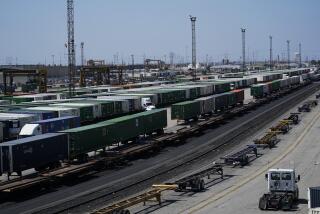Lack of Data Stalled Train Spill Cleanup
- Share via
SEACLIFF — As emergency workers scrambled to clean up the mess from a toxic train derailment here, their greatest obstacle was a lack of information on the shipping manifest listing the hazardous chemicals aboard the Southern Pacific freight train, local authorities said Monday.
Ventura County Fire Department officials said the manifest met federal requirements in listing the broad category of chemicals in each containerized rail car but did not list chemicals by names or detail their quantity and type of containment.
The lack of precise information stymied response efforts and left potentially lethal gas leaking from the wreckage longer than necessary, Ventura County fire officials said.
Coming on the heels of a disastrous train derailment near Sacramento two weeks ago, the Seacliff crash has prompted calls from local officials for greater disclosure of the hazardous substances moved by rail through their area.
“The manifest could not tell us what the chemicals were,” said Ventura County Fire Capt. Dean J. Dysart, head of the hazardous materials team. “There needs to be a lot of improvement in the warning system we’ve got.”
In addition to the criticisms of local emergency officials, an environmental group said the back-to-back spills demonstrate the need for tighter regulations to protect public safety and the environment.
“There is a toxic time bomb ticking out there, and it’s going to explode unless we pass some key legislation,” said Paul Gargan of the California Public Interest Research Group in Los Angeles.
Claire Austin, spokeswoman for the Federal Railroad Administration in Washington, said Monday that Southern Pacific does not appear to have violated any federal rules in connection with the derailment.
“Everything met our requirements,” Austin said. The container was labeled “corrosive” and “combustible,” as required by federal law, she said.
Jack Rich, supervisor of the Public Utility Commission’s railroad operation and safety division said the problems encountered by the Ventura County team illustrates the difficulties for response teams operating under federal reporting requirements.
The PUC is scheduled to vote Aug. 7 on a state order that would require railroads to provide communities with lists of hazardous materials transported through their areas, Rich said.
He added that the state will not be able to mandate disclosures beyond the generic classifications required under federal law.
PUC President Patricia Eckert, who visited the derailment site Monday, said she may move to postpone the commission’s vote to determine if greater safeguards should be put in the order.
Southern Pacific President Mike Mohan, also speaking at the accident scene Monday, disputed charges that emergency workers had no way of figuring out what chemicals might be involved and how to neutralize them.
Mohan said his employees at the site knew almost immediately what chemicals were involved in the accident and shared that information.
Dysart said the key problem in the initial effort at containing possible damage was the vagueness of the shipping documents.
The Southern Pacific shipping manifest carried by the train’s engineer disclosed only that one of the derailed cars was carrying “an aqueous hydrazine” inside a truck trailer loaded on a flatbed that also carried a tank of “aromatic hydrocarbon,” Dysart said.
The hydrocarbon could have been one of 67 chemicals, several of which could have reacted very differently with the hydrazine had the tank ruptured and the two chemicals mixed, Dysart said.
The manifest also did not divulge the percentage of water contained in the aqueous hydrazine. Not until workers wearing protective suits and oxygen tanks ripped a label off one of the 76 drums did Dysart’s team discover that the hydrazine was in a 51.2% solution with water.
Had the solution been greater than 64% hydrazine, Dysart said, it would have been far more combustible and potentially lethal, and he would have been forced to expand the evacuation area beyond Seacliff, nearby campgrounds and oil field operations.
Not until six hours after the accident was it confirmed that the “aromatic hydrocarbon” on the flatbed car was naphthalene, an industrial solvent, Dysart said.
That discovery was welcome news to the emergency crews, Dysart said, because naphthalene does not react violently with hydrazine.
More to Read
Sign up for Essential California
The most important California stories and recommendations in your inbox every morning.
You may occasionally receive promotional content from the Los Angeles Times.










